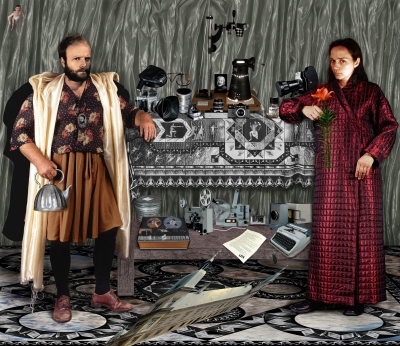Zofia Kulik
Made In GDR, USSR, Czechoslovakia and Poland
The photographic collage Made In GDR, USSR, Czechoslovakia, and Poland refers to the Renaissance painting by Hans Holbein, The Ambassadors. In her work, Kulik replaced the characters of the ambassadors with the image of herself and Przemysław Kwiek, with whom she formed, between 1970-1987, the artistic duo KwieKulik. Whereas Holbein referred to the political and religious divisions in Europe at the time, Kulik draws on the cultural and political divisions between Eastern and Western Europe.
Kulik transforms the allegorical instruments placed in the centre of Holbein’s painting into film and photographic equipment used by her and Kwiek in 1970s and 1980s that often originated from the countries of the former Eastern Bloc: the German Democratic Republic, the Soviet Union, Czechoslovakia, and Poland. An important element of the collage is a carpet covering one of the shelves and another, lying on the floor. This is a clear reference to the artist’s work from the now historical series, Idioms of The Soc–ages series, created mainly in the 1990s.
Another important element of the piece is the view of the Ujazdowski Castle, shown in an anamorphosis, i.e. a deliberate deformation, making it recognizable only when viewed from the right angle. This element is located where the anamorphosis of the skull can be seen in Holbein’s painting. This unsettling Renaissance-painting symbol has been turned into a contemporary sign of opposite meaning – the façade of the Ujazdowski Castle as a cultural institution supporting artists.
Kulik’s piece is a symbolic reference to her work and life. The creation of a double portrait of her and Kwiek as equal characters is a summary of the important, yet rife with conflicts regarding the ideas and primacy, period of their artistic collaboration. Introducing them as ambassadors is also an ironic reckoning with their careers. At the time, artists were not allowed to leave the country, and passport photos taken in 1978 in the hope of an artistic trip, which did not take place, were used in the collage some years later.
